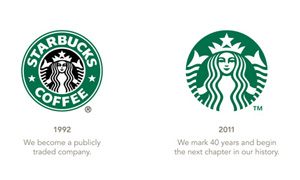Target and Starbucks recently dropped their names from their logos. The Starbucks logo change reflects their belief that they are big enough to not need the name. They’ve transcended the need for letters–it’s so 20th century.
Although many reactions to the Starbucks logo change have been negative, I believe this change attempts to connect to the postmodern consumer experience…and I’m going to bring this around to Jesus and religion in just a moment.
 To oversimplify, postmodernism suggests that our observations and interactions with the world are strictly relative to our experiences and narratives. As a system of thinking, it denies absolute truth and the principle of objectivity.
To oversimplify, postmodernism suggests that our observations and interactions with the world are strictly relative to our experiences and narratives. As a system of thinking, it denies absolute truth and the principle of objectivity.
Target and Starbucks want to tap that idea by using images instead of words to evoke personalized experiences, ideas, and thoughts about their companies.
Consumers don’t want to be told that Starbucks is a coffee shop if they go there for tea, or smoothies, or hot chocolate. Starbucks is an experience of your own making.
Target follows this same thinking…but in a slightly different way.
(See, no words up there on the Target Web site under the bullseye).
 Like many other mega stores these days, I can buy bananas and HDTVs under the same roof. In Target’s case, the wordless bullseye evokes the idea that whatever I need to find, Target will have it. It’s all there under one roof. They want my brain to recall my unique experiences when the store “hit the bullseye” for my needs.
Like many other mega stores these days, I can buy bananas and HDTVs under the same roof. In Target’s case, the wordless bullseye evokes the idea that whatever I need to find, Target will have it. It’s all there under one roof. They want my brain to recall my unique experiences when the store “hit the bullseye” for my needs.
Both of these moves reflect Target’s and Starbucks’ desire to transform their logo into a symbol that will evoke positive emotions about user’s unique and individual experience with the store.
 Other companies like Apple do the same thing with extraordinary success. Looking at the Apple logo, my subconscious mind says: “that
Other companies like Apple do the same thing with extraordinary success. Looking at the Apple logo, my subconscious mind says: “that
picture equals your iPhone 4, which you love, so I am going to make you
feel warm and fuzzy and excited whenever you see that picture.”
When I read the word “Apple,” it doesn’t have the same punch because now
I am thinking about a fruit–not a life-changing piece of consumer
electronics.
The Starbucks logo change lets the consumer define the experience with the company through an image. An image has a more powerful emotional connection to our brain chemistry than words.
 Now, here’s another wordless brand you may have seen before.
Now, here’s another wordless brand you may have seen before.
Oddly, the cross was a first century death penalty torture device. The cross, originally, represented a tool for executing criminals and enemies
The cross is–for better or worse–the primary symbol of Christianity. And when people see the cross, it evokes their experience with Christians and the church.
Even though it is shaped as a lowercase “t,” I am going to bet that most people skip that association and immediately link it with God, church, Jesus, and Christianity in general.
In fact, kids who have been in Sunday School in their preschool years will know it as a “cross” before they know it as a “t.”
Some churches are minimizing symbols like crosses, dropping denominational affiliations from church names, and otherwise distancing themselves from the words and symbols. The relative experience of some tells them that the cross creates the wrong emotional reaction, and so they drop it.
Example: Christ Community Church in Spring Lake, Mich. is now “C3 Exchange.” The cross was removed from the top of the church building, and the words “Christ” and “Church” dropped from the name. This was done to create a more inclusive and accepting community, free from what those words and symbols meant to the outside world. It is an attempt to remove a negative association with the cross as a means to bring in more people. I can’t comment on the church’s orthodoxy in regards to what they teach about Jesus. But it is clear they want to build a wider front door by removing potential obstacles–and in their assessment, the cross and the words “Christian” and “church” are an obstacle.
Unlike Target, Starbucks, or Apple, the symbol of the cross represents something with more history and reach than anything those companies could ever achieve. There is a lot to that image. Inside its borders rests everything good, bad, and ugly about the last 2,000 years of Christianity. And because no one person could possibly connect with all it represents, its meaning can become individualized to our experiences.
Do you think the cross is the primary symbol of the Christian faith, and what do you think it has come to represent to people today? How do you feel about attempts to minimize the cross–or any other traditional symbols or words surrounding the Christian faith?
Click here to subscribe to Red Letters. Click here to follow Tom Davis on Twitter.
